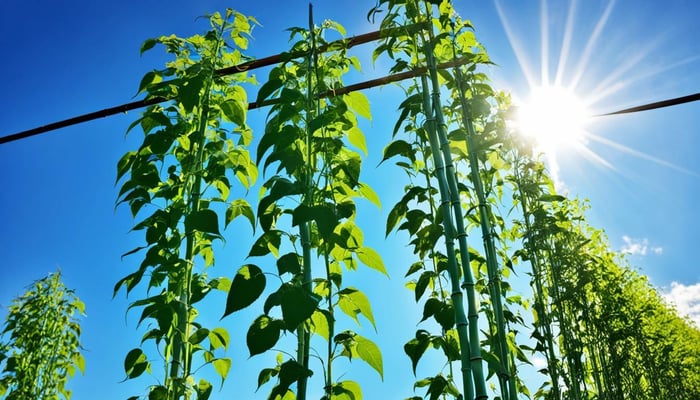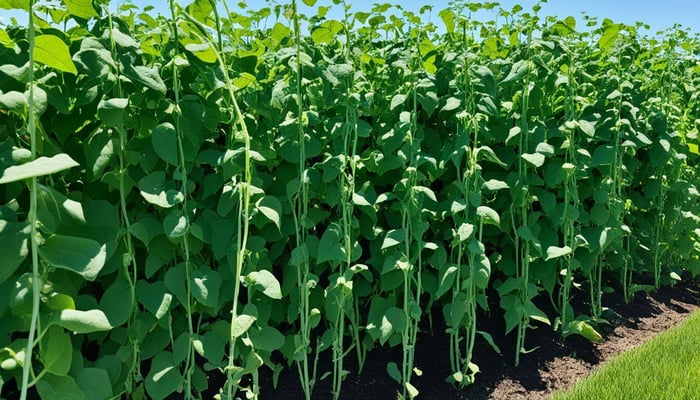Picture this: the soft morning sun casting a warm glow over a sea of vibrant green leaves, with clusters of plump, juicy beans nestled within. This vision isn't just for seasoned gardeners; it could be a slice of your backyard. As a passionate gardener, I find an unparalleled sense of fulfillment when reaping a bountiful harvest right from the soil of my home garden. But what if I told you the key to such richness lies in something as simple as how to grow Contender Beans from seeds? Cultivating Contender Beans isn't just a hobby; it's a journey towards self-sufficiency and garden-to-table living that starts with a single seed.
Nurturing these seeds into flourishing plants promises a rewarding harvest and a season of connection with the earth. Let me escort you through the aromatic aisles of home gardening – where every seed sown is a narrative of growth, patience, and the joys of harvesting nature's produce. The secret? It's all in the approach, and I'm here to share mine.

Key Takeaways
- Discover the satisfaction of growing Contender Beans from the ground up in your home garden.
- Embrace the simplicity of seed cultivation as a gateway to abundant green bean yields.
- Unravel the benefits of choosing Contender Beans for a versatile and hearty crop.
- Gain practical tips to ensure your gardening efforts come to fruition with a bountiful harvest.
- Learn the secrets to selecting, planting, and nurturing your seeds for optimal growth.
Understanding Contender Bush Beans
When I began my gardening adventure, I quickly realized that the Contender bush bean would be a star in my vegetable garden. This bean variety stands out for its ease of growth and resilient nature, making it an accommodating choice for gardeners of all skill levels. The Contender bush beans have proven worth, thriving in various climate conditions and requiring minimal care beyond their love for basking in full sun.
Their compact size is also a huge plus. Compared to their vining counterparts, bush beans tend to grow more contained, making them a perfect garden vegetable for those with limited space. This characteristic alone often earmarks the Contender as a preferred variety. Below is a concise overview of why these beans have entered my garden—and my heart.
| Characteristic | Description |
|---|---|
| Growth Habit | Non-vining, bushy plant renowned for its manageable growth and suitability for compact spaces. |
| Climate Resilience | Adaptable to varying climates, making it a viable option for gardens across diverse regions. |
| Sunlight Requirements | Loves full sun, which contributes to its vigorous growth and bountiful yields. |
| Maturation Time | Fast-maturing, with harvest-ready pods typically forming within 50 days of planting. |
| Pod Texture and Flavor | Offers tender, stringless pods with a crisp texture and delightful flavor, fresh or preserved. |
The Contender's hardiness is unquestionable, with many gardeners noting its ability to push through unexpected cold spells better than other bean varieties. There's something innately rewarding about planting a seed, and with Contender bush beans, the journey from seed to harvest echoes the same resilience and abundance these beans embody.
In my experience, the Contender bush bean is a symbol of generous vegetable yields, stress-free gardening, and the savory rewards of growing a high-performing garden vegetable.
I cannot overstate the contentment of watching these robust plants take shape and produce a harvest that any gardener would be proud of. So when the radiating glow of full sun kisses my garden, I know my Contender beans are soaking it all in, setting the stage for a satisfying and substantial harvest.
Choosing the Right Bean Variety: Contender Beans
As I delve deeper into home gardening, my quest for the perfect bean variety has led me to Contender Beans. These tough little legumes personify resilience and flavor, standing as a testament to the robustness of heirloom seeds. Let me guide you through the distinctive traits of Contender beans that make them an excellent choice for your garden.
Characteristics of Contender Beans
The Contender bean, a hardy bean variety, is revered for its impressive qualities catering to novice and seasoned gardeners. Below, I've detailed elements I have observed that highlight the advantages of planting this particular bean type.
| Trait | Benefit |
|---|---|
| Early Maturity | Excels in quick pod formation, ready for harvest within a short span post-planting. |
| Pod Quality | Yields tender, stringless pods that are rich in flavor and ideal for both raw and cooked consumption. |
| Plant Resilience | Displays a remarkable capacity to withstand cool temperatures, a rare quality among beans. |
| Yield Quantity | Produces an abundant crop, ensuring a plentiful supply throughout the season. |
| Growth Habit | Non-vining, compact stature fits well in smaller spaces and simplifies harvesting procedures. |
The Contender bean's adaptability to climate variations and less demanding growth requirements make it a choice specimen within my garden. Its stringless nature and palatable texture provide a sensory delight fit for various culinary preparations.
Why Gardeners Choose Heirloom Seeds
Like many gardeners, I am drawn to using heirloom seeds for numerous reasons. These seeds passed down through generations, are a legacy in themselves - living pieces of gardening heritage that embody diversity and time-honored quality.
- Genetic Diversity: Embracing many heirloom varieties promotes a gene pool rich in different traits, fortifying the garden ecosystem.
- Flavor Superiority: Heirloom seeds like the Contender often boast superior taste profiles to their hybrid counterparts.
- Sustainability: We contribute to sustainable gardening practices that conserve water and soil health by planting heirloom seeds.
- Seed Saving: Heirloom seeds can be saved and replanted, ensuring a continued lineage and reducing the dependence on the seed market.
In conclusion, the resilience, bountifulness, and palatable virtues of Contender beans make them a matchless candidate in the varied panorama of bean varieties. Coupled with the environmental and cultural benefits of heirloom seeds, it culminates in a gardening choice that is both responsible and immensely gratifying.
Bush Contender Bean Seeds
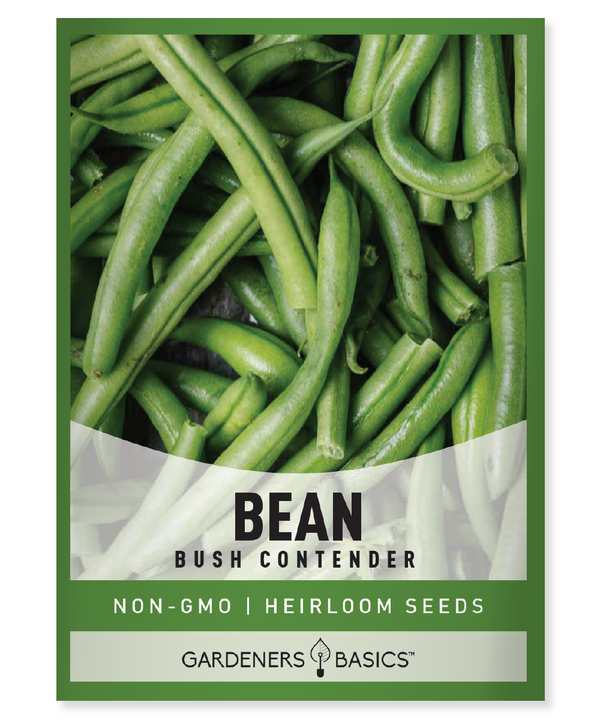
$2.49
Bush Contender Bean Seeds – Heirloom, Non-GMO, Non-Hybrid, Open-Pollinated – Fast-Growing & Easy to Cultivate! Discover the perfect addition to your vegetable garden with Bush Contender Bean Seeds, an heirloom variety celebrated for its reliability, high yield, and versatility. These… read more
The Best Time to Plant Contender Beans
For those of us who cherish the art of gardening, timing our planting to align with the most favorable conditions is a cornerstone of bountiful yields. When it comes to growing beans, especially a robust variety like the Contender, the commencement of the planting season is dictated not just by the calendar but equally by the local frost date. Patience here is not merely a virtue; it's a prerequisite to gardening success. Let me share the timeline I follow to ensure my Contender Beans flourish.
It's essential to be frost-savvy. The frost date is the day, typically estimated, when your area is considered free of the threat of frost. Planting too early can lead to a frostbitten disaster, while planting too late may not give your beans enough time to mature before the hot summer. Therefore, understanding this fine line is vital. A good rule of thumb is to plant your beans two weeks after the last expected frost date. This buffer period ensures the soil has warmed sufficiently for the bean seeds to germinate reliably.
That being said, the anticipation of planting shouldn't overshadow the importance of monitoring current weather trends. With weather patterns shifting unpredictably, paying attention to historical data and climate conditions is prudent.
- Before planting, wait for consistent ground temperatures to reach at least 60°F (15°C).
- Prepare to protect young plants with coverings in case of an unexpected late-season frost.
Below is a table that I use to remind myself and guide newcomers in their gardening, highlighting the critical planting timeframes for Contender Beans:
| Region | Last Expected Frost Date | Planting Window Commences |
|---|---|---|
| Northern States | Late May to Early June | Mid to Late June |
| Midwest | Mid to Late May | Early to Mid-June |
| Southern States | Early to Mid-March | Late March to Early April |
Remember, these dates are only a starting point; your particular locale may experience weather variations that necessitate adjustments. When your Contender Beans have sprouted and begun their journey toward becoming a delightful addition to your kitchen, you’ll know you’ve synced perfectly with nature’s rhythm.
So, as the planting season approaches, keep one eye on the soil and the other on the sky — the dance of elements will dictate when to sow the seeds of your future harvest. Soon enough, you'll be in the delightful throes of beans growing and reaping the joys of your labor.
How to Select High-Quality Bush Bean Seeds
Embarking on the planting journey starts with the quintessential first step: choosing the best seeds. For those with visions of verdant gardens bearing the fruits of their labor, understanding how to select premium bush bean seeds is imperative. This wisdom sows the seeds of success and guarantees that the green canopy in your backyard is the pinnacle of health and vibrancy. Let's delve into the world of seeds, starting with how to pinpoint a seed store that marries quality with reliability.
Gardeners Basics Store
When acquiring top-notch seeds, your gardening triumph hinges on the source; enter our Gardeners Basics seed store. Our garden seeds are fresh, and new seeds are coming in every month.
Recognizing Healthy Seed Traits
Once you've found a trustworthy depot like Gardeners Basics, the next critical step is to discern the traits of healthy bush bean seeds. These diminutive marvels of potential should be unblemished and robust, ensuring they possess the vigor required for optimum germination. Here are some key indicators that I always look for:
- Consistent size and shape: Uniformity in seed size often predicts a uniform germination rate and plant growth.
- Solid coloration: Healthy seeds should have vibrant, consistent coloring without discoloration or spots.
- Firm texture: Viable seeds are resilient when lightly squeezed, not brittle or mushy.
- Free of cracks or holes: The seed's integument should be intact, suggesting that the embryo inside is unharmed and ready for germination.
Focusing on these characteristics has guided me toward selecting seeds that almost always translate into flourishing plants. Remember, the inception of your gardening adventure is encapsulated within these seeds, so opt for excellence from the outset.
Preparing Your Soil for Beans Growing
As a seasoned gardener, I've learned time and again that the bounteous success of my garden is directly tied to the initial steps – specifically, the soil preparation. The feel of rich, nourished earth crumbling between my fingers is the first sign that my Contender Beans will have the fertile ground they need to thrive. Let's talk about optimizing your garden soil for these nutritious legumes.
Soil preparation isn't simply digging a hole and planting a seed; it's an art form, blending science and instinct to create a nutrient-rich cradle for your seeds. The process begins with testing your garden soil to understand its composition and deficiencies. This critical step ensures you know exactly what your soil needs to become a hospitable environment for bean growth. I recommend a home soil test kit or a lab soil analysis for more detailed insights.
Once I've gathered these insights, I incorporate organic matter to amend the soil. This could be compost, aged manure, or leaf mold; they all inject vital nutrients into the garden soil, offering a feast to the delicate roots of your beans. Remember, legumes like Contender Beans enrich the soil with nitrogen but still relish additional nutrients to jumpstart their growth.
A well-aerated soil structure is equally crucial; beans prefer not to have "wet feet." I break the ground and turn it over to introduce air spaces, facilitating root growth and drainage. It's akin to fluffing a pillow for the roots to lay their heads on, ensuring they can breathe and expand without hindrance.
Providing a nutrient-dense and well-drained starting point is non-negotiable for successfully growing beans. It's the foundation upon which all your gardening efforts will flourish or fail.
To wrap it up, here’s a quick checklist for your soil preparation undertakings. Follow these steps, and you're setting up for a season of lush bean growth:
- Test soil for pH level and nutrient balance
- Enrich with plenty of organic matter to improve nutrient content
- Turn the soil to enhance aeration and drainage
- Level the garden bed for uniform seed planting and moisture retention
- Ensure the final texture is loose and crumbly, ideal for the beans' root systems
By dedicating time and effort to these initial steps of soil preparation, you're laying the groundwork - quite literally - for your Contender Beans to emerge strong, resilient, and capable of producing a plentiful harvest. As the season progresses, you'll witness firsthand the impact of nutrient-rich garden soil on the vitality of your bean plants. Happy gardening!
How to Grow Contender Beans From Seeds
Embarking on the cultivation journey of Contender Beans from seed to sprout is a pleasant and fulfilling endeavor for any gardening enthusiast. Carefully sowing seeds and providing diligent seedlings care will reward your efforts with robust green bean growth. It starts with some well-timed sowing and ends with the satisfaction of harvesting your home-grown beans. Let's explore how to set the stage for a prosperous bean bounty.
Seed Safe Survival Seed Kit - 35 Variety Pack
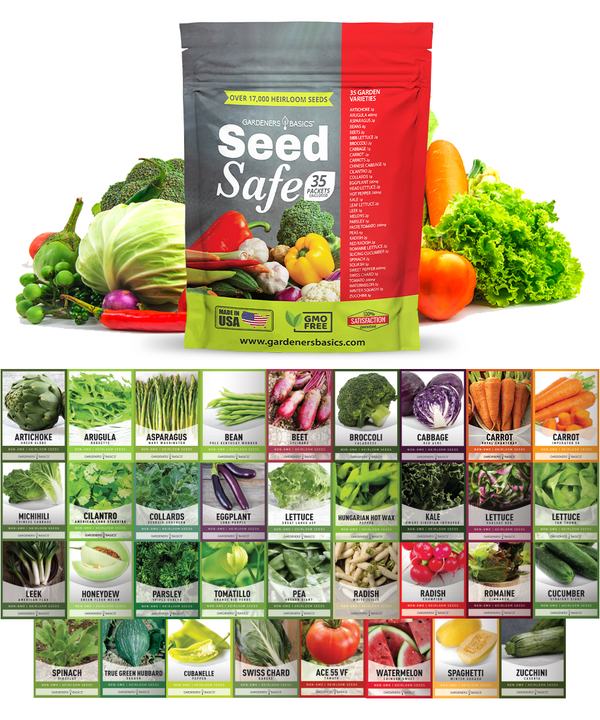
$29.95
$49.95
Seed Safe Survival Seed Kit: The Ultimate Heirloom Collection for Self-Sufficient Gardening Introducing the Seed Safe - 35 Varieties of Heirloom Vegetable, Herb, and Fruit Seeds, the ultimate solution for gardeners who want to secure a bountiful future harvest. This… read more
Sowing Your Contender Bean Seeds
The process begins with choosing the ideal moment for planting. Aim to sow your Contender Bean seeds directly into warm, fertile soil after the danger of the last frost has passed. Planting seeds about 1 inch deep and 2 inches apart in rows about 18-24 inches apart is best. This spacing allows each Contender plant enough room to mature and thrive. Consider planting in successive sowings every two weeks to ensure a continual harvest.
After planting, lightly cover the seeds with soil and provide a gentle watering. Consistency is key in the early stages, as beans require a moist environment that is never waterlogged. Manage water levels carefully to prevent the seeds from rotting before they have a chance to germinate.

Caring for Seedlings in Early Stages
The first shoots usually appear within one to two weeks, depending on soil temperature and moisture levels. From this point, your focus should shift to ensuring the young seedlings receive adequate care to ensure their continued development. A lightweight row cover can protect delicate seedlings from pests and harsh weather, while a thin layer of mulch will help retain soil moisture and temperature and suppress weed growth that could compete with your seedlings for nutrients.
| Seedlings Care Aspect | Recommendations |
|---|---|
| Watering | Keep soil consistently moist but not soggy; overwatering can lead to root diseases detrimental to seedlings. |
| Sunlight | Ensure seedlings receive full sun and at least 6 to 8 hours of direct sunlight daily to promote healthy growth. |
| Soil Temperature | Maintain a soil temperature around 70°F (21°C) for optimal seedling growth. |
| Weed Management | Weed carefully around seedlings to prevent root disturbance; consider mulching to help control weed growth. |
| Fertilization | Apply a balanced fertilizer after the seedlings have sprouted and once more when the plants begin to bloom. |
Thoughtful provision for these young plants will form the foundation of their future productivity. Regular inspections are essential to check for signs of stress or infestation and take timely actions to rectify any issues.
Give your Contender Bean seedlings the attention they need during these early stages. With a rich growing medium, adequate moisture, and vigilant care, you will set them on the path to becoming prolific producers of tasty green beans. Now, watch them grow from vigorous seedlings into full-fledged bean plants, all in the span of your very own garden.
Nurturing Your Contender Beans to Harvest
As a dedicated gardener, nurturing beans is not just an activity but a passion that brings immense satisfaction. The care you put into your garden determines the quality and yield of your green beans. Today, I'm excited to share the essential practices I rely on to guarantee that my Contender Beans thrive from planting to harvest. Follow these tips, and observe as your garden care efforts culminate in a bountiful harvest of crisp, flavorful beans.
Let me walk you through the regimen I employ in nurturing my green beans, ensuring they receive the best possible care:
- Regular Watering: Beans need moisture, especially during flowering and pod formation. I water my beans early in the morning, providing a consistent supply without over-saturating the soil.
- Weed Control: Weeds compete with beans for nutrients and sunlight. My strategy is simple yet effective: regular weeding and the use of mulch to suppress weed growth.
- Pest Management: Pests can be problematic, and I watch for the signs. I prefer organic remedies like neem oil and encourage beneficial insects that serve as natural pest eliminators.
Understanding and responding to the needs of Contender Beans as they grow ensures that when harvest time arrives, your efforts are reflected in the quality and taste of every bean. Here's an in-depth guide in table form that lays out the specifics of an effective bean nurturing strategy:
| Garden Care Aspect | Action | Benefits |
|---|---|---|
| Watering | Provide 1 inch of water per week through rainfall or manual watering. Water at the soil level to avoid wet foliage, which can promote disease. | Ensures steady bean growth and pod development, prevents blossom drop, and assists in forming well-filled pods. |
| Weeding | Hand-pull weeds close to the plants and use shallow cultivation for the rest, taking care not to damage bean roots. | Prevents nutrient competition and reduces habitat for pests and diseases. |
| Mulching | Apply a layer of organic mulch around the plants to conserve moisture and control weeds. | Mulch helps maintain even soil moisture and temperature, which is critical for bean growth. |
| Pest Monitoring | Inspect plants regularly for signs of pests such as bean beetles. Remove by hand or treat with appropriate organic pesticides if necessary. | Keep pest populations in check to prevent damage to foliage and beans, ensuring a healthy crop. |
| Disease Prevention | Implement crop rotation and avoid working in the garden when the foliage is wet to prevent the spread of diseases. | Reduces fungal and bacterial diseases that can decimate a bean crop. |
| Support Structures | Though Contender Beans are bush variety, providing a short stake can help plants stay upright when heavily laden with beans. | Supports better air circulation through the plant, reducing disease and making harvesting easier. |
Remember that consistent, attentive garden care is the secret to fostering a healthy garden brimming with scrumptious green beans. The joy of nurturing beans lies in the anticipation of snapping fresh beans off the vine, bursting with the flavors only home-gardened care can produce. By diligently applying these garden care principles, your Contender Beans' journey from seed to harvest will surely be a triumphant one.
Understanding Frost Dates and Their Impact on Bean Growing
As someone who dedicated countless hours to the garden, I've learned that frost date awareness is crucial for establishing a successful planting strategy, especially for tender crops like beans. The frost date marks the threshold beyond which gardeners can expect temperatures to stay above freezing, critical for the survival of warmth-loving plants. Knowing these dates can help protect beans from frost, ensuring your hard work doesn't go to waste with an untimely cold snap.
Protecting Beans from Late Frost
Sometimes, frost can linger or unexpectedly return, catching gardeners and their beans off guard. When the forecast hints at frost after you've planted, it's essential to be prepared. Protective measures such as floating row covers or cloches can create a microclimate that buffers vulnerable seedlings from the chill. I've used this technique to shield my beans numerous times, and it has often made the difference between a promising crop and a frostbitten disappointment.
- Keep an eye on local weather forecasts for frost warnings.
- Have supplies like plant blankets or plastic sheeting ready for quick deployment.
- Use mulch to insulate the soil and provide extra warmth to the roots.
Timing Your Planting Around Frost Dates
The planting strategy is more than digging a hole and dropping a seed. It's about synchronizing your planting activities with seasonal shifts to foster the best-growing environment. I plan to plant my seeds well after the last frost date to protect the beans effectively. This enhances the chances of your seeds germinating in optimal conditions, free from the hindrance of cold soil or frost damage.
Here's a general guide I've developed for you based on frost date awareness:
| Region | Frost-Free Date Range | Ideal Bean Planting Window |
|---|---|---|
| Northeast | May 15 to May 30 | June 1 to June 15 |
| Midwest | April 15 to May 1 | May 15 to June 1 |
| West Coast | March 1 to March 31 | April 15 to April 30 |
| South | February 15 to March 1 | March 15 to April 1 |
Kicking off your planting after these recommended dates can dramatically increase your chances of a successful harvest. However, personal observation and adjustments will always be key; as we know, nature has a schedule. By marrying our planting strategies with the rhythm of the seasons, we can foster a flourishing environment to grow and protect beans, culminating in the delightful crunch of homegrown legumes on our tables.
Maximizing Sunlight Exposure for Healthy Contender Beans
As someone deeply passionate about gardening, I understand the pivotal role of full sun in cultivating healthy Contender bean plants. These vigorous plants crave the energy only the sun can provide, and ensuring they receive ample sunlight exposure is key to unlocking their potential. I've developed a strategy in my garden to position and maintain my Contender beans for optimal sun absorption, which I am eager to share with you.
Full sun refers to an area receiving direct sunlight for 6 to 8 hours per day, precisely what Contender beans need. Such exposure enhances photosynthesis and reduces the risk of diseases often prevalent in cooler, damp conditions. But how do we maximize this exposure? One of the first tasks is proper plant placement. Contender beans should be strategically planted to bask in the sun's rays throughout the day without obstruction. Such planning significantly contributes to their rigorous growth and abundant yield.
Ultimate Survival Seed Kit: 140 Varieties for Self-Sufficient Gardens & Food Storage
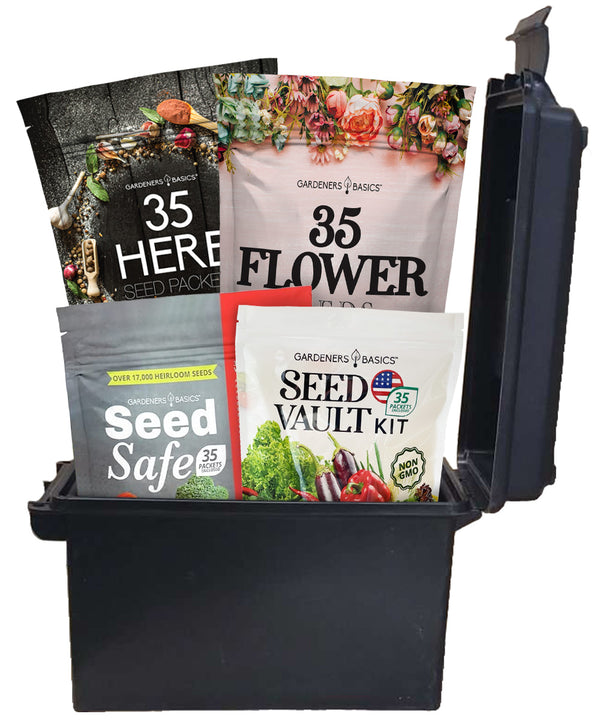
$109.95
$199.95
Ultimate Survival Seed Kit – 140 Variety Pack for Self-Sustaining Gardens, Long-Term Food Storage & FREE Ammo Can for Secure Storage Introducing the Ultimate Survival Seed Kit — your all-in-one solution for sustainable gardening, survival prepping, and self-sufficient living! This… read more
Maintenance plays a critical role, too. As the plants grow, observe their canopy formation. Overcrowding can cast shadows over some plants, reducing their sunlight intake. Here's where strategic pruning comes in—trimming excess foliage ensures each plant receives full sun and improves air circulation, which is vital for plant health. Here’s a table that summarizes my approach to maximizing sunlight exposure for Contender Beans, which has served me well:
| Aspect of Sunlight Exposure | Recommendations |
|---|---|
| Plant Orientation | Align rows north to south for even sunlight distribution on both sides of the plants throughout the day. |
| Time of Day for Full Sun | Morning to mid-afternoon, to utilize the peak hours of sun intensity. |
| Pruning for Sunlight | Regularly prune or thin the foliage to prevent overshadowing and to ensure all leaves receive sun. |
| Plant Spacing | Space plants adequately apart as per seed packet instructions to avoid competition for sunlight. |
| Reflective Mulches | Use reflective mulches to increase light exposure to the lower parts of the plants. |
By embracing and implementing these practices, I’ve consistently enjoyed the sight of my vibrant green Contender beans and the pleasure of a hearty harvest. Remember, while Contender beans are forgiving, they perform best when offered the critical ingredient of bright, generous sun. So, let’s step out, shall we? It's time to make the most of the sunlight and watch your Contender bean plants translate rays into bountiful green treasures.
Frequent Watering and Mulching Techniques
Optimal care for Contender Beans or snap beans requires a precise watering schedule and astute use of mulching—a dynamic duo that contributes significantly to plant health and yield. By understanding their synergistic benefits, you can cultivate a thriving snap bean patch to be proud of. Let's dive into the how and why of these critical farming practices.
Watering Schedule for Optimal Bean Growth
Maintaining a consistent watering schedule is crucial for their development in nurturing snap beans. Contender Beans, with their crisp pods and lush foliage, demand a careful moisture balance. I've found that providing them with about an inch of water per week works wonders, though checking the soil moisture levels can indicate the need for a bit more during peak summer heat. Always aim to water early in the morning; this reduces evaporation and gives the plants time to dry off before evening, which can help prevent fungal diseases.
For me, the true measure of the watering schedule's efficacy is in the tender crunch of a freshly picked snap bean, and I can tell you—that crunch is the sound of perfection.
To convey the essence of a watering schedule that results in a garden of flourishing Contender Beans, here's a simple table that outlines my approach:
| Plant Growth Stage | Watering Frequency | Watering Amount |
|---|---|---|
| Seedling | Daily | Light spritz to keep the soil moist |
| Flowering | Every other day | Heavier soak to encourage pod formation |
| Pod Development | Twice a week | 1 inch around the base, avoiding foliage |
| Harvest | As needed | Consistent moisture to maintain pod quality |
The Benefits of Mulching
Mulching benefits in a snap beans garden are manifold, making it an indispensable part of snap beans care. A layer of organic mulch such as straw or well-rotted compost helps retain soil moisture, balance temperature fluctuations, and keep weeds at bay. I've consistently utilized mulch in my Contender Beans garden and observed a notable improvement in soil quality and plant vigor, which is especially critical during those sweltering midsummer days.
Moreover, mulching can enhance the biological ecosystem in your garden, encouraging beneficial microorganisms and earthworms that naturally till the soil and improve its nutrient content. This organic activity also aids in gradually breaking down the mulch into compost, further enriching the soil.
Implementing these frequent watering and mulching techniques into your garden regimen will set your snap beans up for success. Remember, the care you give now shines through in the healthy snap of each bean harvested, providing sustenance and satisfaction from your home garden.

Troubleshooting Common Issues with Growing Green Beans
As I walk through my garden, full of lush Contender Beans, it's a reminder that despite the beauty, growing green beans can present challenges. Even the most vigilant gardeners can encounter issues. I'm here to share my hands-on experience in troubleshooting green beans and offering solutions to common growing issues to foster healthy beans.
One of the frequent troubles I've come across is yellowing leaves. When the foliage loses its vibrant green hue, it usually signals a lack of nutrients, particularly nitrogen. Contender Beans are nitrogen-fixing plants that benefit from a balanced, slow-release fertilizer. Applying organic compost can provide a natural boost and support lush growth.
In my early days, I noticed my bean plants were sometimes stunted and didn't flourish as expected. Upon investigation, I discovered it was a case of compacted soil. Beans require a loose, well-draining soil to thrive. Aerating my garden beds and incorporating organic matter was the key to resolving this issue.
Another vexatious problem is bean rust, easily identified by the brown, powdery spots on leaves. It's a fungal disease that thrives in damp environments. To prevent it, I ensure proper plant spacing for air circulation and water my beans at the soil level to minimize splashback. If rust appears, affected leaves must be removed and destroyed to prevent further spread.
Pests like aphids and bean beetles can also derail your green bean efforts. My go-to solution is to attract beneficial insects like ladybugs or apply neem oil as an organic pest control measure. Regular inspections are vital; catching a problem early can mean distinguishing between a minor setback and a lost crop.
I cannot stress enough the importance of monitoring your plants closely. Beans are usually hardy, but they can have their off days. Here's a table I put together to share with you; it's been helpful in my garden, and I hope it will be in yours, too.
| Issue | Cause | Solution |
|---|---|---|
| Yellowing Leaves | Nutrient Deficiency | Apply organic compost or a balanced slow-release fertilizer. |
| Stunted Growth | Compacted Soil | Aerate soil and mix in organic matter to improve drainage and texture. |
| Bean Rust | Fungal Disease | Remove affected leaves, improve spacing, and apply fungicide if necessary. |
| Pest Infestations | Aphids, Bean Beetles | Introduce beneficial insects or apply organic pesticides like neem oil. |
Patience and perseverance in troubleshooting green beans are paramount. My garden taught me that problems are just opportunities to learn and grow. For every issue I've encountered, I've found a solution that strengthens my resolve to nurture healthy beans, ensuring that the journey from planting to picking is as smooth as possible.
Harvesting and Storing Your Contender Snap Beans
The culmination of our gardening efforts is at hand when the Contender Beans reach their prime. With the green foliage giving way to bountiful, snappable pods, it's clear that the harvest season has arrived. Fresh produce from the garden offers unbeatable flavor and the pride of personal accomplishment. Let's delve into spotting those perfect pickings and ensuring they stay fresh once they journey from vine to storage.
Recognizing the Perfect Harvest Time
To ensure the freshest quality and the best texture, it's essential to pinpoint the optimal time for harvesting Contender Beans. These beans are best picked when they reach about four to six inches long, displaying a firm texture and a vibrant green color. The pods should snap easily when bent — a surefire indicator that they are ready to be harvested. Harvesting in the morning, when the dew has dried, is ideal as the beans are crisper and more hydrated than later in the day. Regular harvesting also encourages the plants to produce more beans, extending the yield of your crop.
Tips for Storing Beans to Maintain Freshness
After picking your beans, knowing how to properly store them is essential for preserving their crispness and flavor. The goal of storing green beans is to maintain their garden-fresh quality as long as possible. First, refrain from washing the beans until ready to use them, as the additional moisture can promote mold. To store, place the unwashed green beans in a plastic bag and leave it partially open to allow for air circulation. Then, store the bag in the crisper drawer of your refrigerator. The beans should keep well for about seven to ten days.
For longer storage, blanching, and freezing, Contender Beans is an excellent option. Blanch the beans for three minutes in boiling water, then transfer them to an ice-water bath to halt the cooking process. Dry the beans thoroughly before transferring them to freezer bags and store them in the freezer, where they can last for several months while retaining much of their fresh flavor and texture.
Whether enjoying them immediately or storing them for the future, your garden's bounty can be a source of delight and nourishment beyond the growing season. With these methods for harvesting and storing, your Contender Beans can continue to add freshness and flavor to your meals long after they've been plucked from the vine.
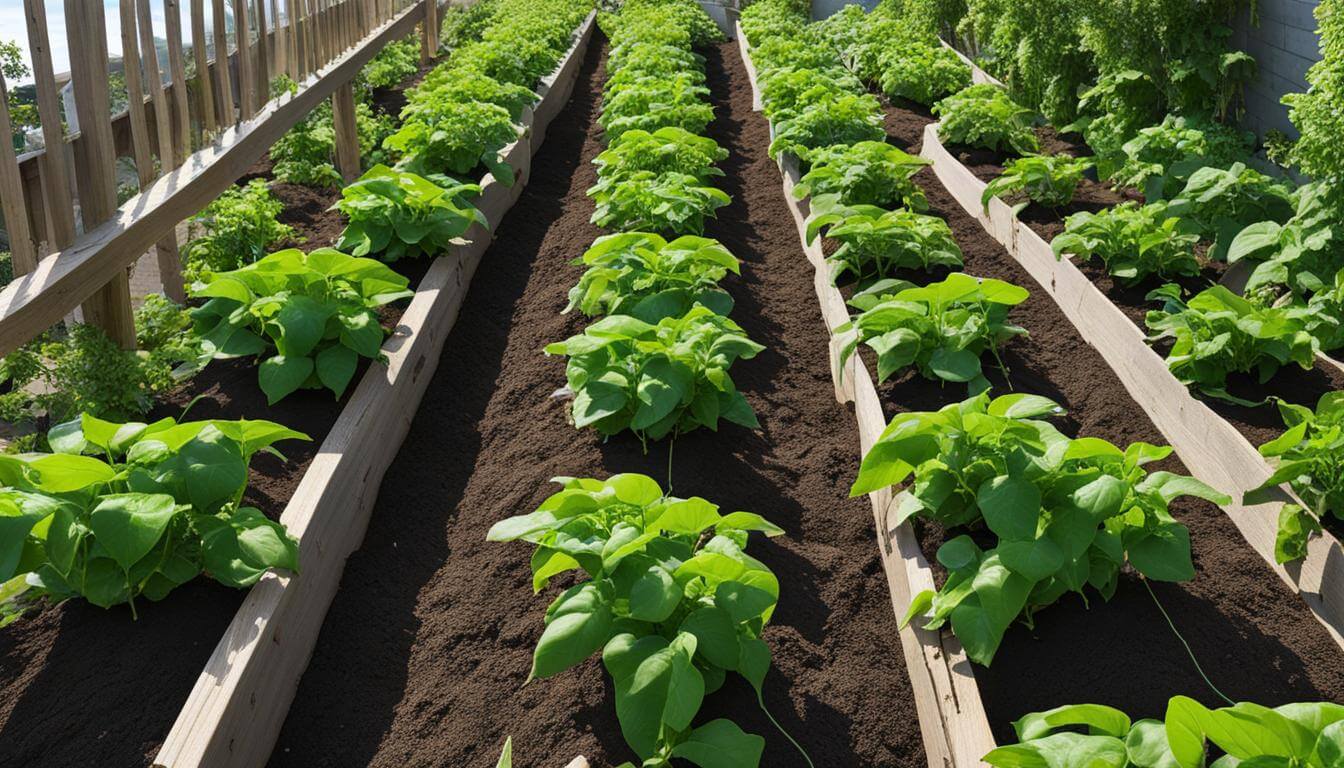
Conclusion - How to Grow Contender Beans From Seeds
The journey through the verdant world of Contender Beans culminates in a moment that embodies pure home gardening satisfaction—a successful harvest. To stand amid the rows of your garden, hands filled with the fruits of your labor, reinforces the gratification of self-reliance and connection to the earth. It's a testament to the commitment and care invested from the first seed sown to the last bean picked.
I hope the insights shared here embolden you to embark on your own horticultural adventure, armed with comprehensive tips for every stage of your Contender Beans' life cycle. The knowledge laid before you—from selecting the best seeds and preparing your soil to nurturing your plants and perfecting your harvesting technique—forms a blueprint for a fruitful garden experience.
Whether you're a green-thumbed veteran or a novice to the trowel and hoe, the success of your garden hinges on the principles of diligent care and the joy of tending to garden life. Embrace the fullness of this experience, for the seasonal cycle of growing Contender Beans isn’t just about cultivating plants; it’s about cultivating joy, peace, and a sense of achievement that enriches our plates and souls. May your harvests be plentiful, and may the sense of satisfaction from your garden resonate through every aspect of your life.
Bush Tendergreen Bean Seeds
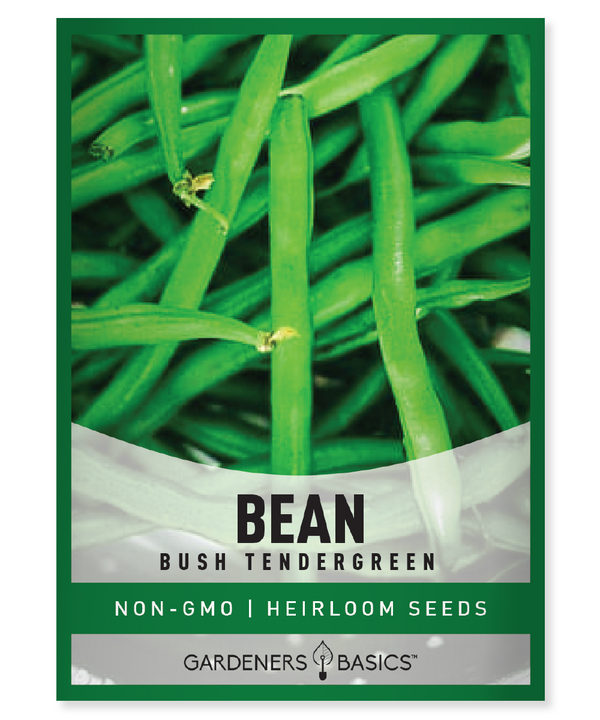
$2.49
Bush Tendergreen Bean Seeds - Heirloom, Non-GMO, High-Yield, Stringless Green Beans Grow your garden with Bush Tendergreen Bean seeds, a classic heirloom variety known for its tender, stringless pods and robust flavor. Our non-GMO, non-hybrid, open-pollinated seeds ensure you’ll enjoy reliable… read more
Bush Tendergreen Bean Seeds

$2.49
Bush Tendergreen Bean Seeds - Heirloom, Non-GMO, High-Yield, Stringless Green Beans Grow your garden with Bush Tendergreen Bean seeds, a classic heirloom variety known for its tender, stringless pods and robust flavor. Our non-GMO, non-hybrid, open-pollinated seeds ensure you’ll enjoy reliable… read more
FAQ - How to Grow Contender Beans From Seeds
How do I start growing Contender Beans from seeds?
To start growing Contender Beans, choose a location in your garden that gets full sun. Prepare the soil by tilling and adding organic matter. Plant the seeds about an inch deep and three inches apart after your last frost date when the soil has warmed. Water them well and wait for germination, which typically takes 7-10 days.
What makes Contender Bush Beans a preferred garden vegetable?
Contender Bush Beans are a beloved bean variety due to their ability to thrive in full sun and adapt to various climates. They produce a bountiful harvest relatively quickly and are known for being a hardy plant that resists common diseases. Their versatility and ease of growth make them an excellent choice for novice and experienced gardeners.
Why should I consider planting heirloom seeds like Contender Beans?
Heirloom seeds, such as those from Contender Beans, are cherished for their historical significance and the genetic diversity they offer. Gardeners often choose them for their superior flavor, texture, and the unique traits preserved over generations. Heirloom seeds can also contribute to biodiversity in your home garden.
When is the best time to plant Contender Beans?
The ideal time to plant Contender Beans is after the danger of frost has passed and the soil temperature is at least 60°F. This typically falls in late spring, but you should always check your local frost date to decide the perfect planting time for your region.
How do I select the best bush bean seeds?
When selecting bush bean seeds, such as those for Contender Beans, look for high-quality seeds from a reliable seed store like Gardeners Basics. Ensure the seeds are free from cracks, wrinkles, or any signs of mold and mildew. Healthy seeds should be plump and have a consistent color.
What are the key steps in preparing my soil for Contender Beans?
To prepare your soil, first remove any weeds or debris. Loosen the soil to a depth of 8-10 inches and integrate a generous amount of compost or aged manure to add nutrients. Ensure the soil is well-drained and has a neutral pH to create a favorable environment for beans growing.
Can you offer any advice for sowing and caring for Contender Bean seedlings?
When sowing Contender Bean seeds, plant them directly into prepared soil about 1 inch deep. Keep the soil consistently moist as the seedlings emerge and provide support if necessary. Thin the seedlings if they're too crowded to promote better air circulation and growth.
What are the best practices for nurturing Contender Beans?
Nurturing Contender Beans involves regular watering, especially during dry periods, mulching to retain soil moisture, and weeding to prevent competition for nutrients. Additionally, protect the plants from pests and diseases by practicing crop rotation and using organic pest control methods when needed.
How do frost dates impact my Contender Beans growing schedule?
Frost dates play a crucial role in planning your planting schedule. You should plant Contender Beans after the last frost date in spring to prevent the young plants from being damaged by cold temperatures. Likewise, be aware of the first frost date in the fall if you're planting a late crop.
How do I ensure my Contender Beans get enough sunlight?
Plant your Contender Beans in a part of the garden that receives full sun, which means at least 6 to 8 hours of sunlight daily. Avoid areas overshadowed by trees or buildings to ensure your plants have the best conditions for healthy growth and a prolific yield.
What watering and mulching techniques are effective for Contender Beans?
Contender Beans should be watered deeply and regularly during dry spells to maintain even soil moisture. Mulching with organic material such as straw or grass clippings will help conserve moisture, regulate soil temperature, and suppress weeds, which is beneficial for the overall health of snap beans.
How do I troubleshoot common issues when growing green beans?
To troubleshoot common issues, ensure your Contender Beans are planted in full sun with well-drained soil to prevent diseases. Control pests through manual removal or organic pesticides. If your plants display signs of nutrient deficiency, test your soil and adjust your fertilization strategy accordingly.
What are the indicators that my Contender Snap Beans are ready to harvest?
Contender Snap Beans are ready to harvest when the pods are firm and snap easily. They should be about 4 to 6 inches long and have a bright green color. Harvesting regularly when the beans are at this stage will encourage the plants to produce more pods.
Any tips for storing my harvested Contender Beans to maintain freshness?
To store your harvested Contender Beans and maintain their freshness, wash the beans and pat them dry. Place them in a perforated plastic bag and refrigerate. Blanch the beans in boiling water, cool them in ice water, and freeze them in an airtight container or freezer bag for longer-term storage.



